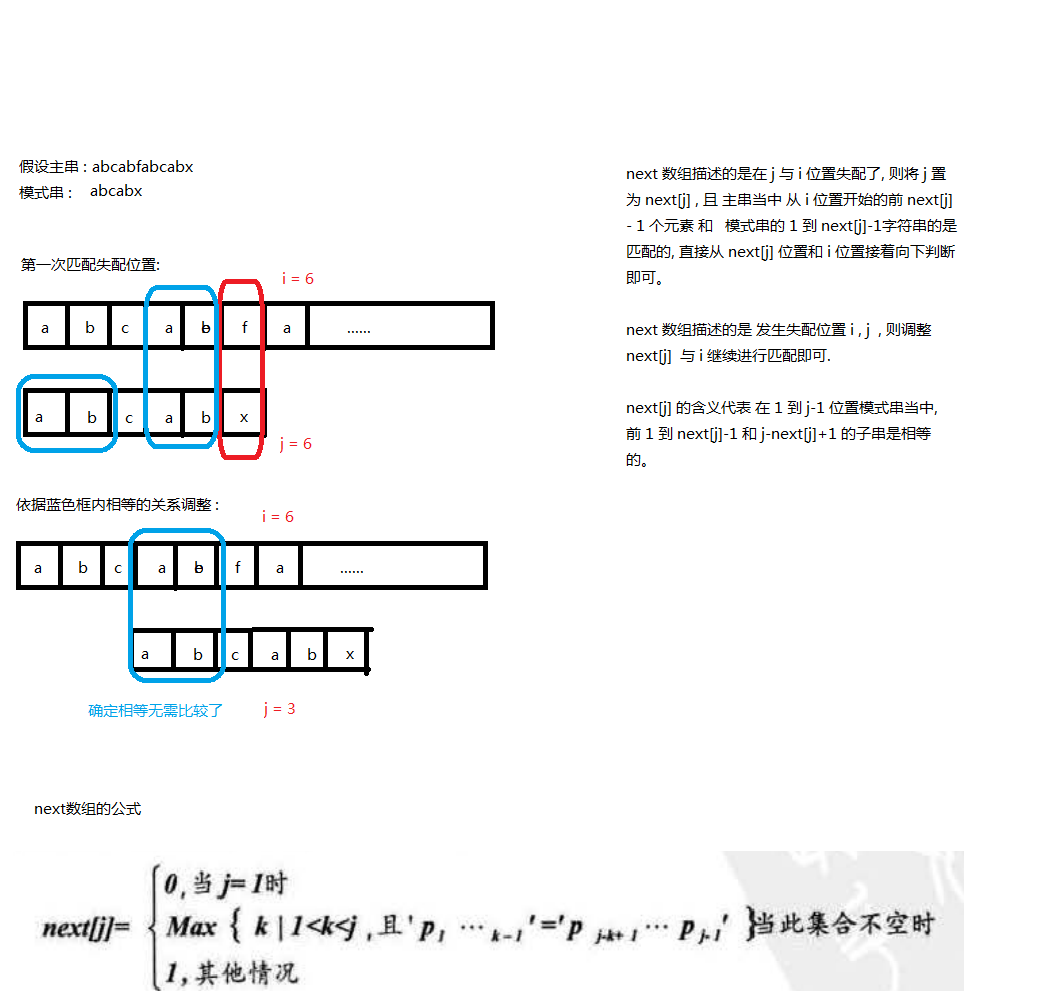
!!! 注意: 此图是本书中使用的自定的串结构, 下标从1开始的 , 下方代码是使用C风格字符串, 下标从0开始的, 因此上述next[j] 公式修改如下:

KMP 算法代码实现:
以普通的C风格字符串作为例子。

#include <stdio.h> #include <string.h> #include <stdlib.h> #define NDEBUG /*需要调试信息输出请注释此宏*/ /*获取next数组*/ void get_next(const char *t, int *next) { int i,j; i = 0; j = -1; /*调整j为-1,代表主串从失配位置下一个位置 在 和模式串重头开始匹配*/ next[0] = -1; int t_len = strlen(t); while(i < t_len) { if(-1 == j || t[i] == t[j]) { ++i; ++j; next[i] = j; }else{ j = next[j]; } } } /*匹配, 在main串中匹配pattern*/ int subString(const char *s, const char *t) { int i = 0; /*指向mian串字符位置的指针*/ int j = 0; /*指向pattern串字符位置的指针*/ int s_len = strlen(s); int t_len = strlen(t); int * next = (int *)malloc(sizeof(int) * (t_len)); get_next(t, next); while(i < s_len && j < t_len) { /*等于-1 说明将i+1的位置 和 模式串的0位置的字符串在进行匹配就行了*/ if( -1 == j || s[i] == t[j]) { i++; j++; } else /*失配调整位置*/ { /*下方代码块儿 输出调试信息, 方便理解KMP算法 , 可以删除*/ { #ifndef NDEBUG int len = i - j; int k; printf("-------------------lose-------------------------- "); printf(" i : %d -- j : %d ", i, j); printf("%s ", s); for(k = 0; k<i;++k) printf(" "); printf("^ "); for(k = 0; k<len;++k) printf(" "); printf("%s ", t); printf("-------------------------------------------------- "); #endif } j = next[j] } } free(next); if(j >= t_len) return i - t_len; else return -1; } int main() { const char *t = "abcade"; const char *s = "abxabdabcade"; int result = subString(s, t); printf("%d ",result); return 0; }
KMP优化:
例子1:
s : a a a a a a b c x a a a a a a a
t : a a a a a a a
next[t] = -1 0 1 2 3 4 5
如上方的例子:
在 i = 5 且 j = 5 的位置发生了失配, 那么 j 会调整到 j = 4 继续 与 i = 5 匹配 又发生失配, j又
调整到 j = 3 一直调整到 j = 0 的时候-1标志才会让 i 加1, 进而完成一次 I的调整 。可见从
s[5] != t[5] 的那次失配的其, next调整到4, 3 , 2 , 1 完全是多余的, 直接调整到 0 就行啦。
则
那么求next数组的算法进行如下优化:
void get_next(const char *T, int *next) { int i = 0, j = -1; next[0] = -1; while(i < strlen(T)) { // T[i] 表示后缀的单个字符 // T[j] 表示前缀的单个字符 if(j == -1 || T[i] == T[j]) { ++i; ++j; if(next[i] != next[j]) next[i] = j; else next[i] = next[j]; } else j = next[j]; } }
